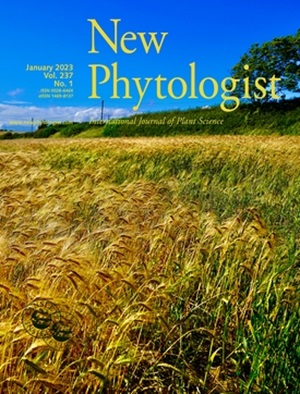Extranuclear function of Arabidopsis HOOKLESS1 regulates pleiotropic developmental processes in a non-cell-autonomous manner
IF 8.1
1区 生物学
Q1 PLANT SCIENCES
引用次数: 0
Abstract




拟南芥HOOKLESS1的核外功能以非细胞自主的方式调控多效性发育过程
许多植物突变体表现出高度多效性表型,通常参与植物激素的合成、失活或信号转导。植物激素的下游信号成分,如转录因子,在不同组织中往往是非常多样化的,这可能导致它们具有高度的多向性功能(Wolters &;更加与众不同,2009)。虽然迄今为止已确定了约10种植物激素,但据预测,许多具有植物激素样活性的物质仍未确定。例如,植物特异性细胞色素P450家族CYP78A与新型生物活性物质的合成有关(Anastasiou et al., 2007)。这一观点得到了以下观察结果的支持:CYP78A5/KLUH以非细胞自主的方式起作用,CYP78A5单突变体和CYP78A5 cyp78a7双突变体表现出明显的多效表型,包括质体长度短、开花早、顶端优势性降低、器官大小减小、不育和系结(Anastasiou et al., 2007;Adamski et al., 2009;Eriksson等人,2010;Poretska et al., 2020;Nobusawa et al., 2021)。CYP78A5的功能似乎不依赖于已知的植物激素(Wang et al., 2008)。为了避免在土壤中萌发时受到伤害的风险,在黑暗条件下,绝大多数苦苣苔植物在黄化的幼苗中产生顶端钩。几种植物激素,包括生长素、乙烯、赤霉素、油菜素类固醇和茉莉酸(JA),已知与钩子形成有关。Kleine-Vehn, 2018;王,郭,2019)。拟南芥HOOKLESS1 (HLS1)被认为是钩形成的关键调控因子。例如,hls1的零突变体即使在乙烯的存在下也表现出完全无钩的表型,乙烯强烈促进钩的形成(Guzmán &;埃克,1990)。然而,事实上,HLS1表现出高度多效性的功能,影响除了顶端钩形成之外的各种植物发育过程,如叶片数(质体线长度)、叶片衰老、疾病易感性、开花时间和热形态发生(Li et al., 2004;廖等,2016;Jin et al., 2020)。此外,HLS1的四重突变体及其类似的HLS1- like HOMOLOG (HLH) 1-3表现出HLS1单突变体所没有的多种表型,如侏儒症和子叶数量频繁增加(Chang et al., 2013)。HLS1与n -乙酰转移酶家族具有显著的同源性,尽管其具体的底物仍有争议。Liao等(2016)通过ChIP实验发现,HLS1在WRKY33和ABA INSENSIGTIVE 5基因的转录起始位点(TSS)和编码序列(CDS)上富集,并且在HLS1突变体中组蛋白H3的乙酰化水平降低,提示HLS1是一种组蛋白乙酰化转移酶。然而,他们无法在体外检测HLS1的组蛋白乙酰转移酶活性。另一方面,Huang等(2024)发现自噬相关蛋白18a (autophagy - related PROTEIN18a, ATG18a)是自噬的关键因子之一,在营养缺乏诱导的衰老过程中作为HLS1乙酰化的底物。然而,他们发现自噬并不参与钩的形成,这表明ATG18a并不是植物发育中所有涉及HLS1的现象的普遍底物。据报道,HLS1与多种蛋白相互作用。Lyu等人(2019)报道,在光照条件下,HLS1通过核内寡聚化激活,通过与光敏色素B (PhyB)结合而失活。Guo等人(2023)报道HLS1结合乙烯信号转导因子ethylene INSENSITIVE 2 (EIN2), Wang等人(2023a)报道HLS1结合促花转录因子CONSTANS, Xiong等人(2023)报道HLS1结合小泛素样修饰物E3连接酶。此外,如前所述,Huang等人(2024)发现HLS1也与ATG18a结合。这些不同的HLS1相互作用物可能解释了HLS1的多效性功能。然而,这些相互作用形成了一个高度复杂的网络,对HLS1功能的全面和统一的认识仍有待建立。除了hls1突变体外,还发现了许多其他具有无钩表型的突变体。转录因子EIN3、乙烯不敏感的LIKE 1和光敏色素相互作用因子(PHYTOCHROME INTERACTING factors, pif)通过协同增强HLS1的表达,在钩子形成的调控中起着至关重要的作用。值得注意的是,这些因素的多重突变呈现出完全的无钩表型(An et al., 2012;Shi et al., 2018;Zhang et al., 2018)。此外,还发现了参与生长素或油菜素类固醇合成和信号传导的突变体,以及控制光形态发生的调节体,如CONSTITUTIVE PHOTOMORPHOGENIC1 (COP1) (Mazzella et al., 2014)。 值得注意的是,改变的分生系统程序1 (amp1)/cop2突变体也表现出无钩表型(Lehman et al., 1996;拉兹,埃克,1999)。AMP1编码一种被认为与通过miRNA调控翻译有关的羧基肽酶(Li et al., 2013)。然而,AMP1的分子功能尚不清楚。有趣的是,除了无钩表型外,amp1还表现出一系列在hs1中也观察到的多效表型,如缩短的生长期、早开花和早衰老(Chaudhury等人,1993;Kong et al., 2015;Poretska et al., 2020;Nobusawa et al., 2022)。在本研究中,我们对hls1和hlh1双突变体进行了详细的表型分析,证实了hls1 / hlh1功能的广泛多效性。我们发现,HLS1经常在不同于那些表现出表型表现的组织中表达,这表明HLS1以非细胞自主的方式发挥作用。我们的研究表明,HLS1在细胞质和细胞核中表现出弥漫性定位模式,并且HLS1在细胞核外的存在足以补充HLS1表型。遗传分析表明,HLS1和AMP1在质体时间调控中作用于同一途径。此外,人们认为HLS1不直接参与已知植物激素的合成或失活。我们的研究结果表明,HLS1作为一种乙酰转移酶,在核外和潜在的核内代谢底物,以非细胞自主的方式调节植物发育的多效性现象,并在一个不同于已知植物激素的新网络中起作用。
本文章由计算机程序翻译,如有差异,请以英文原文为准。
求助全文
约1分钟内获得全文
求助全文
来源期刊

New Phytologist
生物-植物科学
自引率
5.30%
发文量
728
期刊介绍:
New Phytologist is an international electronic journal published 24 times a year. It is owned by the New Phytologist Foundation, a non-profit-making charitable organization dedicated to promoting plant science. The journal publishes excellent, novel, rigorous, and timely research and scholarship in plant science and its applications. The articles cover topics in five sections: Physiology & Development, Environment, Interaction, Evolution, and Transformative Plant Biotechnology. These sections encompass intracellular processes, global environmental change, and encourage cross-disciplinary approaches. The journal recognizes the use of techniques from molecular and cell biology, functional genomics, modeling, and system-based approaches in plant science. Abstracting and Indexing Information for New Phytologist includes Academic Search, AgBiotech News & Information, Agroforestry Abstracts, Biochemistry & Biophysics Citation Index, Botanical Pesticides, CAB Abstracts®, Environment Index, Global Health, and Plant Breeding Abstracts, and others.
 求助内容:
求助内容: 应助结果提醒方式:
应助结果提醒方式:


